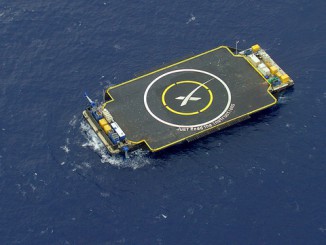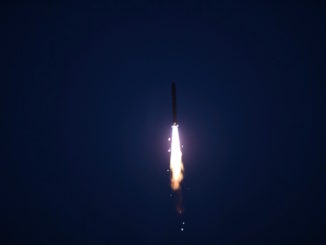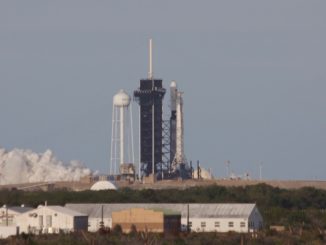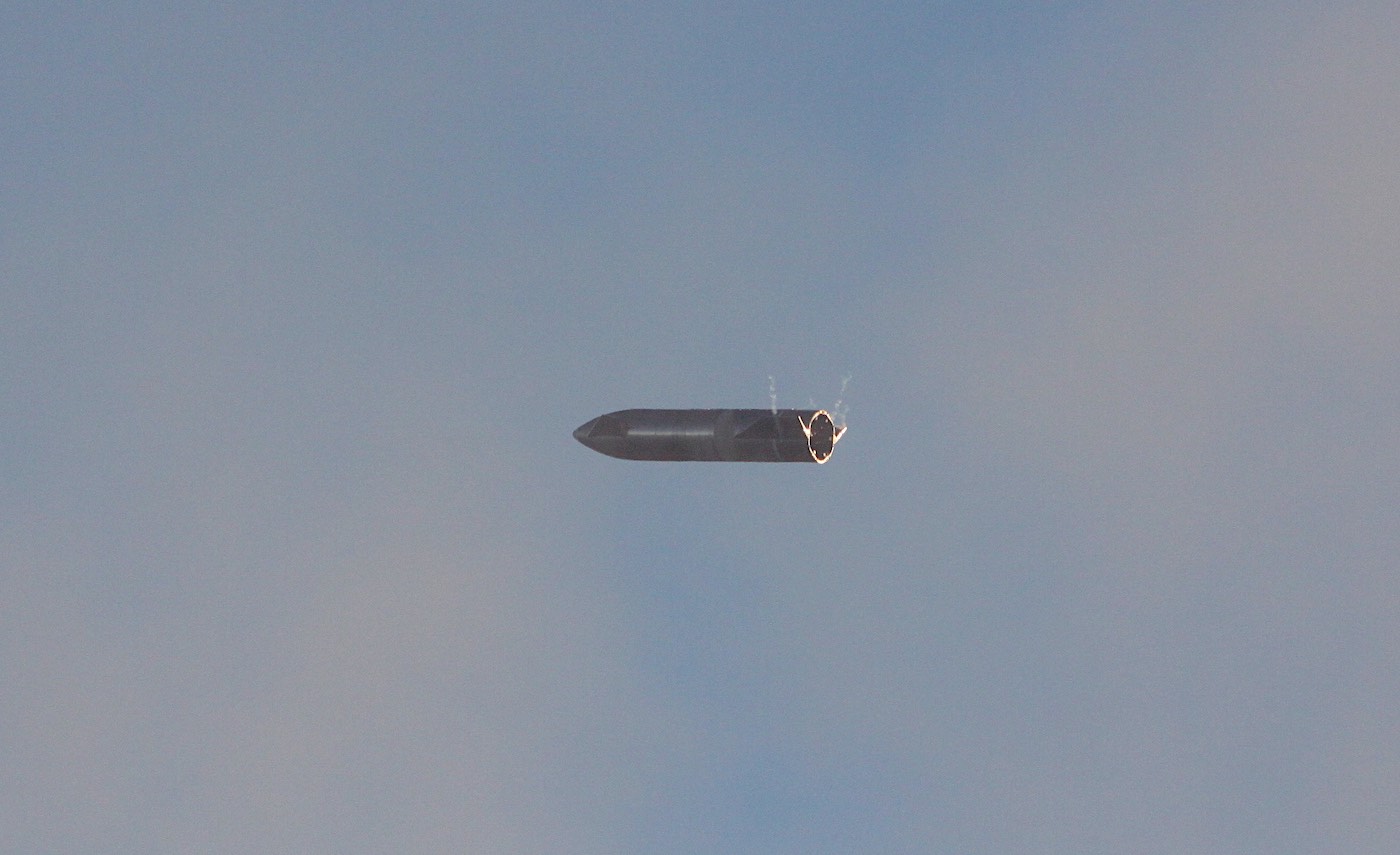
A full-size prototype of SpaceX’s heavy-lift Starship launch vehicle soared high into the atmosphere Wednesday in a spectacular test flight over South Texas, and successfully guided itself to a beachside landing site before exploding at touchdown.
Elon Musk, SpaceX’s founder and CEO, hailed the nearly seven-minute test flight as a success.
“Mars, here we come!” Musk tweeted. “Thank you, South Texas for your support! This is the gateway to Mars.”
Designed for vertical takeoffs and vertical landings, the Starship is part of a giant new rocket SpaceX says will carry more than 100 tons of cargo into space per mission, and as many as 100 people on expeditions to Mars.
The privately-developed Starship’s three Raptor engines performed well, Musk tweeted, but low pressure inside the nose cone tanks feeding the engines during their landing burn caused the rocket to crash-land in a fireball, scattering metallic debris across SpaceX’s launch facility at Boca Chica, Texas, near the U.S.-Mexico border.
“Successful ascent, switchover to header tanks & precise flap control to landing point!” Musk tweeted. “Fuel header tank pressure was low during landing burn, causing touchdown velocity to be high & RUD [Rapid Unscheduled Disassembly], but we got all the data we needed! Congrats SpaceX team hell yeah!!”
The 164-foot-tall (50-meter) Starship test vehicle — designated Serial Number 8, or SN8 — took off at 4:45 p.m. CST (5:45 p.m. EST; 2245 GMT) Wednesday from SpaceX’s rocket development and test facility at Boca Chica, located on the Texas Gulf Coast east of Brownsville.
Three Raptor engines, burning methane mixed with super-cold liquid oxygen, ignited with a flash of orange to power the Starship rocket off the launch pad with more than a million pounds of thrust, delighting crowds gathered in South Texas to witness the test flight, and thousands more watching the launch online.
The Starship SN8 test vehicle slowly climbed off the launch pad, trailing a flickering flame of super-heated exhaust, and soared high into the atmosphere, targeting an altitude of 41,000 feet, or 12.5 kilometers, higher than most commercial airliners fly.
One of the Raptor engines shut down a little more than a minute-and-a-half into the flight, followed by cutoff of a second engine more than three minutes after liftoff. The remaining engine switched off at about T+plus 4 minutes, 40 seconds, and the Starship’s thrusters and control flaps put the rocket in a horizontal “belly flop” orientation for the descent back to the ground.
Live views from Starship test rocket streamed online by SpaceX showed vehicle’s control surfaces moving to help steer the rocket during its fall through the atmosphere. Local residents and space enthusiasts watching the flight in person let out cheers as the rocket took off, then again as it began its fall back to Earth.
In a mesmerizing scene, the rocket appeared to glide through the atmosphere, appearing like a shining airship from an earlier era of flight.
Seconds before reaching the ground, two of the Starship’s Raptor engines reignited and vectored their thrust as the rocket’s control surfaces flexed to quickly flip the rocket into a vertical position for landing.
The stainless-steel rocket’s guidance system appeared to steer the Starship over its landing pad, just east of where the vehicle took off to begin the test flight. One of the engines appeared to shut down moments later, with a flash of green in the rocket’s exhaust plume.
The 30-foot (9-meter) wide Starship — wider than the fuselage of a Boeing 747 jumbo jet — settled onto the landing pad at high speed, and the rocket erupted in a giant fireball. When the smoke cleared, the landing site was littered with mangled metallic debris, while text appeared on SpaceX’s official live stream saying “Awesome test. Congrats Starship team!”
Musk said the Raptor engines “did great” on the Starship SN8 test flight. The methane-fueled Raptor is SpaceX’s most advanced rocket engine, generating more than twice the thrust of the kerosene-fueled Merlin engine flown on the company’s currently operational Falcon 9 rockets.
“SN8 did great! Even reaching apogee would’ve been great, so controlling all way to putting the crater in the right spot was epic!!” Musk tweeted.
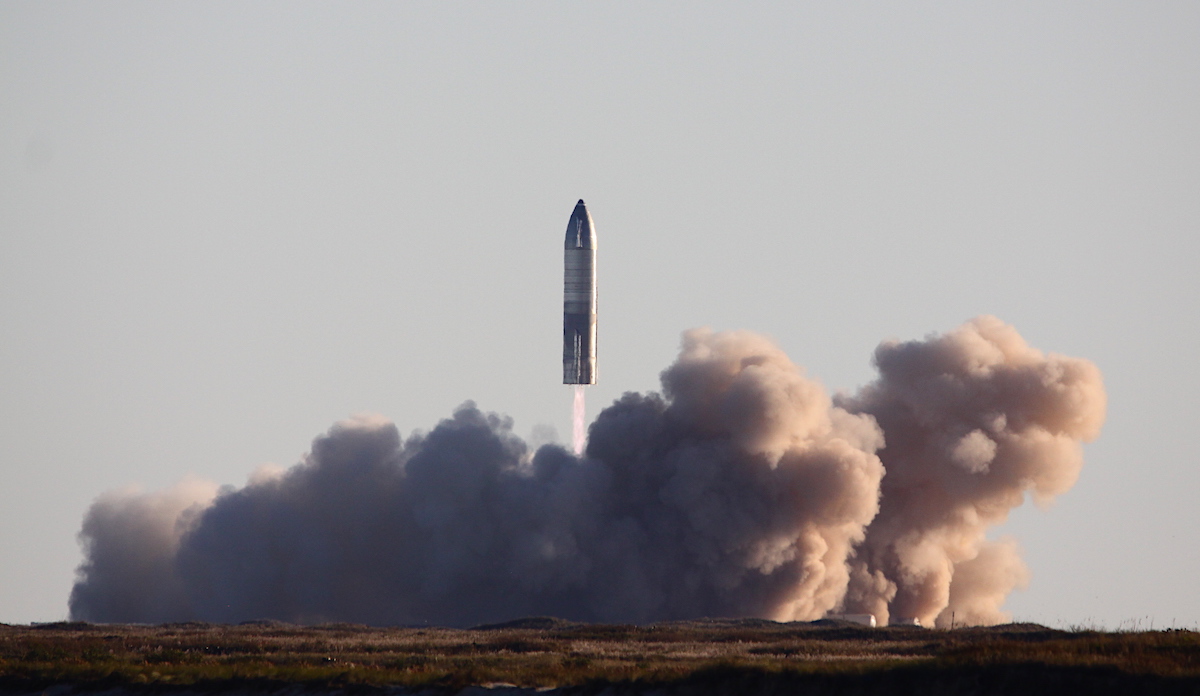
In a more detailed statement, SpaceX officials wrote that the Starship test rocket “successfully ascended, transitioned propellant, and performed its landing flip maneuver with precise flap control to reach its landing point. Low pressure in the fuel header tank during the landing burn led to high touchdown velocity resulting in a hard (and exciting!) landing.”
Jeff Bezos, the billionaire founder of Amazon.com and rocket company Blue Origin, congratulated SpaceX on the successes from Wednesday’s test flight.
“Anybody who knows how hard this stuff is is impressed by today’s Starship test,” Bezos wrote. “Big congrats to the whole SpaceX team. I’m confident they’ll be back at it soon.”
“Congrats to SpaceX for achieving this milestone,” tweeted Thomas Zurbuchen, head of NASA’s science directorate. “I stopped the NASA meeting I was in and we all watched the flight together. I walked away with a much better understanding of the profound differences of Starship as compared to other rockets.”
The test flight Wednesday afternoon came after SpaceX halted a launch attempt earlier in the day. SpaceX aborted a countdown Tuesday afternoon just one second before launch.
Before Wednesday’s test flight, SpaceX had performed two “hop” tests with full-scale Starship prototypes, each reaching an altitude of about 500 feet, or 150 meters. Last year, SpaceX flew a subscale Starship test vehicle dubbed the Starhopper on 66-foot (20-meter) and 500-foot test flights.
With good outcomes from those flights, SpaceX was ready to reach higher. Unlike the previous Starship test flights, the vehicle that launched Wednesday had a nose cone, forward aerosurfaces, and body flaps to help control the vehicle in the atmosphere.
“It just falls like a skydiver, and it’s just controlling itself, and it turns and lands,” Musk said in a presentation on the Starship program last year. “It’ll look totally nuts to see that thing land.”
Musk estimated the Starship SN8 rocket had a one-in-three chance of completing all its objectives Wednesday. The primary purposes of the experimental mission Wednesday were to gather data on how clusters of multiple Raptor engines perform in flight and assess the aerodynamic handling characteristics of the full-scale Starship.
Previous low-altitude, low-speed test flights only had a single Raptor engine and did not require aerosurfaces on the vehicle. Those flights did not test out the Starship’s “belly flop” descent and flip maneuver just before landing.
The throttleable Raptor engine is the most powerful engine SpaceX has developed, achieving the highest combustion chamber pressure of any rocket engine in history. Capable of 500,000 pounds of thrust at full throttle, the Raptor is more than twice as powerful as the Merlin engine that flies on SpaceX’s Falcon 9 rocket.
The methane-fueled Raptor is also easier to reuse than the kerosene-fueled Merlin engine, and uses a technically complex full-flow staged combustion design intended to maximize performance.
SpaceX says it has accumulated more than 16,000 seconds of run time during 330 ground engine starts on Raptor engines, including Starship test-firings and four Starship and Starhopper test flights.
“Additionally, with production accelerating and fidelity increasing, SpaceX has built 10 Starship prototypes,” SpaceX said. “SN9 is almost ready to move to the pad, which now has two active stands for rapid development testing.”
SpaceX has rapidly expanded its South Texas production and launch facility, which now has a large vertical rocket integration building and an ever-growing footprint of support buildings, fuel farms, and other infrastructure.
Future operational Starships could ferry people to the moon, Mars, and other destinations in deep space.
The Starship will function as the upper stage on a towering launch vehicle standing nearly 400 feet tall (120 meters). The first stage on the huge launcher, named the Super Heavy, will be powered by 28 Raptor engines.
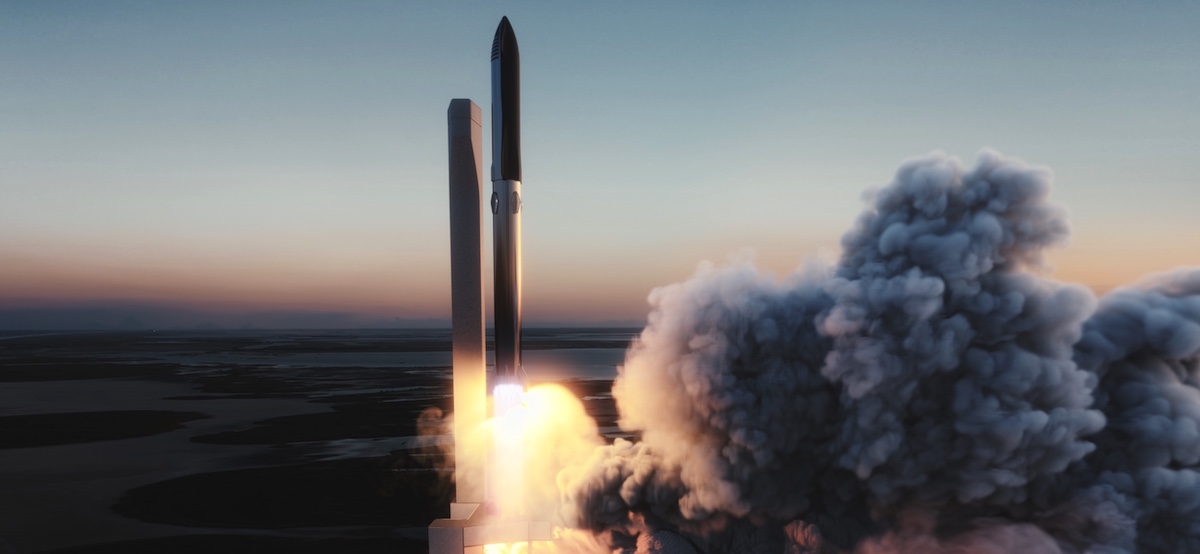
Once operational, the Starship could carry more than 100 metric tons, or 220,000 pounds, of cargo to low Earth orbit, more than any rocket in the world. With life support systems and in-space refueling, Starship missions could eventually transport people to the moon, Mars, and other distant destinations.
Starship is central to the vision of Musk, who established the company with a mission of sending people to Mars.
Musk has emphasized SpaceX’s progress on production capabilities and ground infrastructure, allowing the company to rapidly build prototypes, test them, and introduce upgrades and modifications on follow-on vehicles.
SpaceX has started building parts of the first Super Heavy booster. Like the early Starship test flights, the first Super Heavy prototypes will fly to low altitudes with just a few Raptor engines.
For an orbital mission, the Starship will also need a heat shield for re-entry.
Both stages will come back to Earth for propulsive landings, much like the first stage on SpaceX’s partially reusable Falcon 9 rocket. That will make the Super Heavy and Starship fully reusable, drastically lowering the system’s operating costs, according to SpaceX.
NASA, meanwhile, is developing a giant government-owned rocket named the Space Launch System. The single-use SLS is four years behind schedule and running over-budget. NASA hopes to launch the SLS with an unpiloted Orion capsule to orbit the moon and come back to Earth on a test flight before the end of 2021, followed by missions to the moon with astronauts.
No stranger to setting out ambitious schedules for SpaceX programs, Musk said in October that he is “80 to 90% confident that we will reach orbit with Starship next year.”
Musk said last year said the first orbital launch of Starship could happen in 2020. Despite the fast rate of progress, SpaceX won’t meet that schedule.
In August, Musk said that SpaceX is not yet performing much development of the life support systems Starships will need to accommodate people. That will come after SpaceX can prove the vehicle can fly successfully.
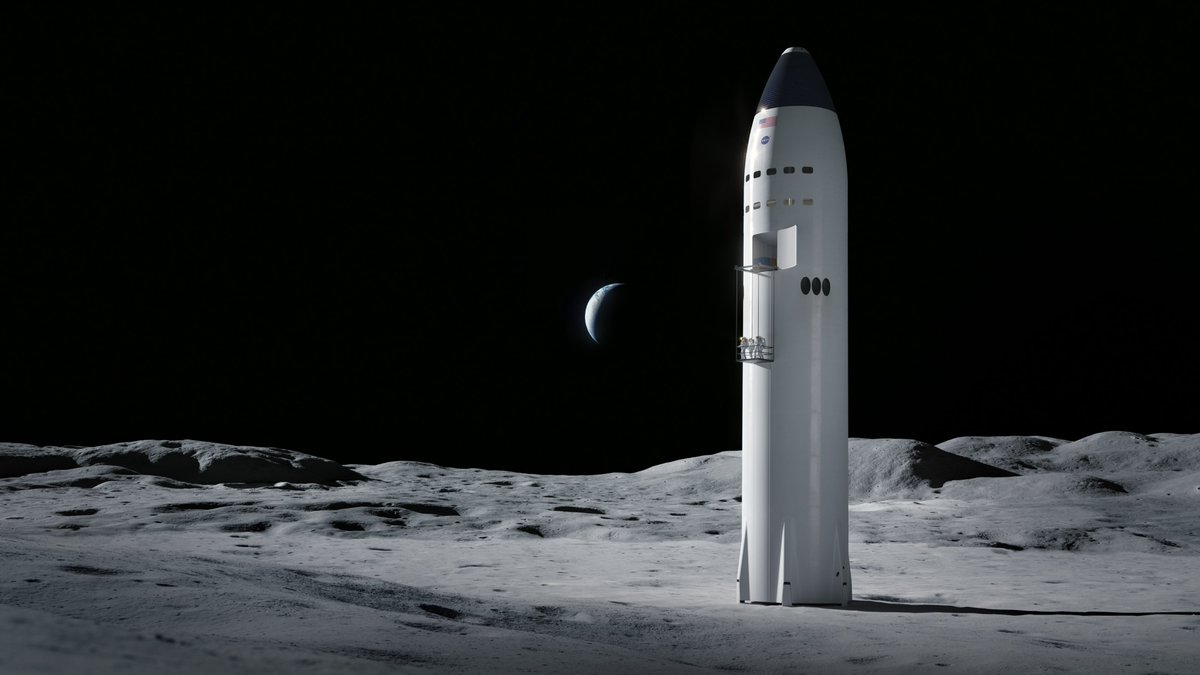
SpaceX’s longer-term roadmap includes an in-orbit refueling capability to make trips to the moon possible. NASA selected SpaceX’s Starship vehicle in May as one of three contenders — alongside Blue Origin and Dynetics — for a human-rated lunar lander the space agency will fund for crewed moon missions later this decade.
In the scenario NASA envisions, astronauts would launch on the Space Launch System and fly an Orion crew capsule to the vicinity of the moon, then dock with a waiting lunar lander to transport them to the lunar surface and back to the Orion for the return trip to Earth.
The moon missions will require SpaceX to master in-orbit refueling between two Starships. Musk said earlier this year he thinks SpaceX has a shot of accomplishing that in 2022.
More recently, in a Dec. 1 ceremony in Berlin in which he received the Axel Springer Award from the German publishing company, Musk said he is “highly confident” that SpaceX could achieve the first human landing on Mars in six years.
“If we get lucky, maybe four years,” he said. “And we want to try to send an uncrewed vehicle there in two years.”
Keeping up with SpaceX hastening pace of production at Boca Chica, the next Starship prototype — designated SN9 — is nearly complete inside a vertical hangar just down the road from the Starship launch site. It will soon be transported to the launch pad for pre-launch testing and a test flight that could happen in a matter of weeks.
Email the author.
Follow Stephen Clark on Twitter: @StephenClark1.

